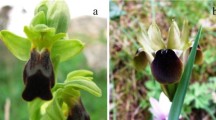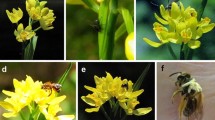Abstract
The pollination of one plant species can be facilitated by the presence of one or more neighboring plant species and evidence has been found in some rewardless species of orchid that benefit from the presence of rewarding plant species in the neighborhood. There are two pollination mechanisms by which a non-rewarding orchid attracts pollinators and increases its reproductive success: (1) A magnetic species effect that occurs even though the flowers do not resemble those of the other species, and (2) floral mimicry where the mimic’s flower resembles that of the model plant species. Oncidium cosymbephorum is a Mexican rewardless epiphytic orchid whose flowers look like those of the rewarding shrub Malpighia glabra (Malpighiaceae). The resemblance of O. cosymbephorum to the oil-offering flowers of M. glabra attracts the same pollinators, and the fitness of the orchid is higher when M. glabra is present than when it is absent. We evaluated the facilitation by M. glabra of the orchid’s pollination for natural and artificial clumps of O. cosymbephorum close to and far from M. glabra over 4 years. Two experiments were performed at five different study sites to evaluate the effect of the presence and absence of M. glabra on the reproductive success of O. cosymbephorum. In experiment 1, we recorded fruit set production in natural and artificial monospecific clumps of the orchid, and in natural and artificial heterospecific clumps of O. cosymbephorum and M. glabra. In experiment 2, we recorded the fruit set of O. cosymbephorum at different sites where individuals grow in monospecific clumps, both before and after cultivated individuals of oil-producing M. glabra had been planted in their vicinity. Both experiments showed that the reproductive success of O. cosymbephorum was greater in the presence of M. glabra than it was in its absence. This study provides experimental evidence for the magnetic species effect. Floral similarity between O. cosymbephorum and M. glabra, should be experimentally tested to determine whether it is adaptive.


Similar content being viewed by others
References
Ackerman JD (1986) Mechanisms and evolution of food deceptive pollination systems in orchids. Lindleyana 1:108–113
Alexandersson R, Ǻgren J (1996) Population size, pollinator visitation and fruit production in the deceptive orchid Calypso bulbosa. Oecologia 107:533–540. doi:10.1007/BF00333945
Anderson W (1979) Floral conservatism in Neotropical Malpighiaceae. Biotropica 11:219–223. doi:10.2307/2388042
Anderson B, Johnson SD (2006) The effects of floral mimics and models on each others’ fitness. Proc R Soc Lond B Biol Sci 273:969–974. doi:10.1098/rspb.2005.3401
Bierzychudek P (1981) Asclepias, Lantana and Epidendrum: a floral mimicry complex? Biotropica 13:54–58. doi:10.2307/2388070
Buchmann SL (1987) The ecology of oil flowers and their bees. Annu Rev Ecol Syst 18:343–369. doi:10.1146/annurev.es.18.110187.002015
Carmona-Díaz G (2001) Floral mimicry between Oncidium cosymbephorum Morren (Orchidaceae) and Malpighia glabra L. (Malpighiaceae). Master of Science Thesis. Universidad Veracruzana, Xalapa, Veracruz, Mexico
Castillo-Campos G, Laborde J (2004) La vegetación. In: Guevara S, Laborde J, Sánchez G (eds) Los Tuxtlas: El Paisaje de la Sierra. Instituto de Ecología A.C.. Unión Europea, Xalapa, Ver, pp 231–265
Castillo-Campos G, Medina ME (2005) Árboles y arbustos de la Reserva Natural de La Mancha, Veracruz, México. Instituto de Ecología A.C., Xalapa, Ver, p 143
Chase MW, Hanson L, Albert VA, Whitten WM, Williams NH (2005) Life history evolution and genome size in Subtribe Oncidiinae (Orchidaceae). Ann Bot (Lond) 95:191–199. doi:10.1093/aob/mci012
Cristobal-Azkarate J, Vea J, Ascencio N, Rodríguez-Luna E (2005) Biogeographical and floristic predictors of the presence and abundance of mantled howlers (Alouatta palliata mexicana) in rainforest fragments at Los Tuxtlas, Mexico. Am J Primatol 67:209–222. doi:10.1002/ajp.20178
Dafni A, Ivri Y (1981a) Floral mimicry between Orchis israelitica Baumann and Dafni (Orchidaceae) and Bellevalia flexuosa Boiss (Liliaceae). Oecologia 49:229–232. doi:10.1007/BF00349193
Dafni A, Ivri Y (1981b) The flower biology of Cephalanthera longifolia (Orchidaceae) pollen imitation and facultative floral mimicry. Plant Syst Evol 137:229–240. doi:10.1007/BF00982788
Feinsinger P (1987) Effect of plant species on each other’s pollination: is community structure influenced? Trends Ecol Evol 2:123–126. doi:10.1016/0169-5347(87)90052-8
Feldman TS, Morris WF, Wilson WG (2004) When can two plant species facilitate each other’s pollination? Oikos 105:197–207. doi:10.1111/j.0030-1299.2004.12845.x
Gigord LDB, Macnair M, Stritesky M, Smithson A (2002) The potential for floral mimicry in rewardless orchids: an experimental study. Proc R Soc Lond B Biol Sci 269:1389–1395. doi:10.1098/rspb.2002.2018
Hegland SJ, Totland O (2005) Relationships between species’ floral traits and pollinator visitation in a temperate grassland. Oecologia 145:586–594. doi:10.1007/s00442-005-0165-6
Internicola A, Juillet N, Smithson A, Gigord LDB (2006) Experimental investigation of the effect of spatial aggregation on reproductive success in a rewardless orchid. Oecologia 150:435–441. doi:10.1007/s00442-006-0530-0
Internicola A, Page PA, Bernasconi G, Gigord LDB (2007) Competition for pollinator visitation between deceptive and rewarding artificial inflorescences: an experimental test of the effects of floral colour similarity and spatial mingling. Funct Ecol 21(5):864–872. doi:10.1111/j.1365-2435.2007.01303.x
Jersáková J, Johnson SD, Kindlmann P (2006) Mechanisms and evolution of deceptive pollination in orchids. Biol Rev Camb Philos Soc 81:219–235. doi:10.1017/S1464793105006986
Jiménez R (1993) Los géneros Lophiaris y Oncidium en México. Primer Simposio Internacional de Orquideología, Xalapa, Veracruz, México
Johnson SD (1994) Evidence for Batesian mimicry in a butterfly-pollinated orchid. Biol J Linn Soc Lond 53:91–104
Johnson SD (2000) Batesian mimicry in the non-rewarding orchid Disa pulchra, and its consequences for pollinator behavior. Biol J Linn Soc Lond 71:119–132
Johnson SD, Nilsson LA (1999) Pollen carryover, geitonogamy, and the evolution of deceptive pollination system in orchids. Ecology 80:2607–2619
Johnson SD, Peter CI, Nilsson LA, Ǻgren J (2003a) Pollination success in a deceptive orchid is enhanced by co-occurring rewarding magnet plants. Ecology 84:2919–2927. doi:10.1890/02-0471
Johnson SD, Alexandersson R, Linder HP (2003b) Experimental and phylogenetic evidence for floral mimicry in a guild of fly-pollinated plants. Biol J Linn Soc Lond 80:289–304. doi:10.1046/j.1095-8312.2003.00236.x
Juillet N, Gonzalez MA, Page PA, Gigord LDB (2007) Pollination of the European food-deceptive Traunsteinera globosa (Orchidaceae): the importance of nectar-producing neighbouring plants. Plant Syst Evol 265:123–129. doi:10.1007/s00606-006-0507-9
Lammi A, Kuitunen M (1995) Deceptive pollination of Dactylorhiza incarnata: an experimental test of the magnet species hypothesis. Oecologia 101:500–5003. doi:10.1007/BF00329430
Laverty TM (1992) Plant interaction for pollinator visits: a test of the magnet species effect. Oecologia 89:502–508
Moeller DA (2004) Facilitative interactions among plants via shared pollinators. Ecology 85:3289–3301. doi:10.1890/03-0810
Neiland MR, Wilcock C (1998) Fruit set, nectar reward, and rarity in the Orchidaceae. Am J Bot 85:1657–1671. doi:10.2307/2446499
Rathke BJ (1988) Interactions for pollination among co-flowering shrubs. Ecology 69:446–457. doi:10.2307/1940443
Renner SS (2006) Rewardless flowers in the Angiosperms and the role of insect cognition in their evolution. In: Waser NM, Olerton J (eds) Plant pollinator interactions: from specialization to generalization. University of Chicago Press, Chicago, pp 123–144
Roy BA, Widmer A (1999) Floral mimicry: a fascinating yet poorly understood phenomenon. Trends Plant Sci 8:325–330. doi:10.1016/S1360-1385(99)01445-4
Sabat AM, Ackerman JD (1996) Fruit set in a deceptive orchid: the effect of flowering phenology, display size, and local abundance. Am J Bot 83:1181–1186. doi:10.2307/2446202
Serio-Silva JC, Rico-Gray V, Hernández-Salazar LT, Espinosa-Gómez R (2002) The role of Ficus (Moraceae) in the diet and nutrition of a troop of Mexican howler monkeys Alouatta palliata mexicana, released on an island in Southern Veracruz, Mexico. J Trop Ecol 18:913–928. doi:10.1017/S0266467402002596
Thomson JD (1978) Effects of stand composition on insect visitation in two-species mixtures of Hieracium. Am Midl Nat 100:431–440. doi:10.2307/2424843
Van der Pijl L, Dodson CH (1966) Orchid flowers, their pollination and evolution. University of Miami Press, Coral Gables
Vogel S (1990) History of the Malpighiaceae in the light of pollination ecology. Mem N Y Bot Gard 55:130–142
Waser NM, Chittka L, Price MV, Williams NM, Ollerton J (1996) Generalization in pollination systems, and why it matters. Ecology 77:1043–1060. doi:10.2307/2265575
Zar JH (1986) Biostatistical analysis. Prentice-Hall, New Jersey
Acknowledgments
The authors thank Drs. Juan Francisco Ornelas, Carlos Vergara, and Matthias Laska for suggestions on early drafts. Suggestions of two anonymous reviewers helped to improve the manuscript. Apolinar García-Hoyos, and Saul Hernández helped with the field work. Rosario Landgrave made the map of the study sites. Bianca Delfosse revised the English version. This study was funded by the Instituto de Ecología, A.C. (907-04-144), the Universidad Veracruzana, and the Consejo Nacional de Ciencia y Tecnología (CONACYT doctoral fellowship 124848 to GCD), and is part of the doctoral research in Ecología y Manejo de Recursos Naturales being done by GCD.
Author information
Authors and Affiliations
Corresponding author
Rights and permissions
About this article
Cite this article
Carmona-Díaz, G., García-Franco, J.G. Reproductive success in the Mexican rewardless Oncidium cosymbephorum (Orchidaceae) facilitated by the oil-rewarding Malpighia glabra (Malpighiaceae). Plant Ecol 203, 253–261 (2009). https://doi.org/10.1007/s11258-008-9543-6
Received:
Accepted:
Published:
Issue Date:
DOI: https://doi.org/10.1007/s11258-008-9543-6




